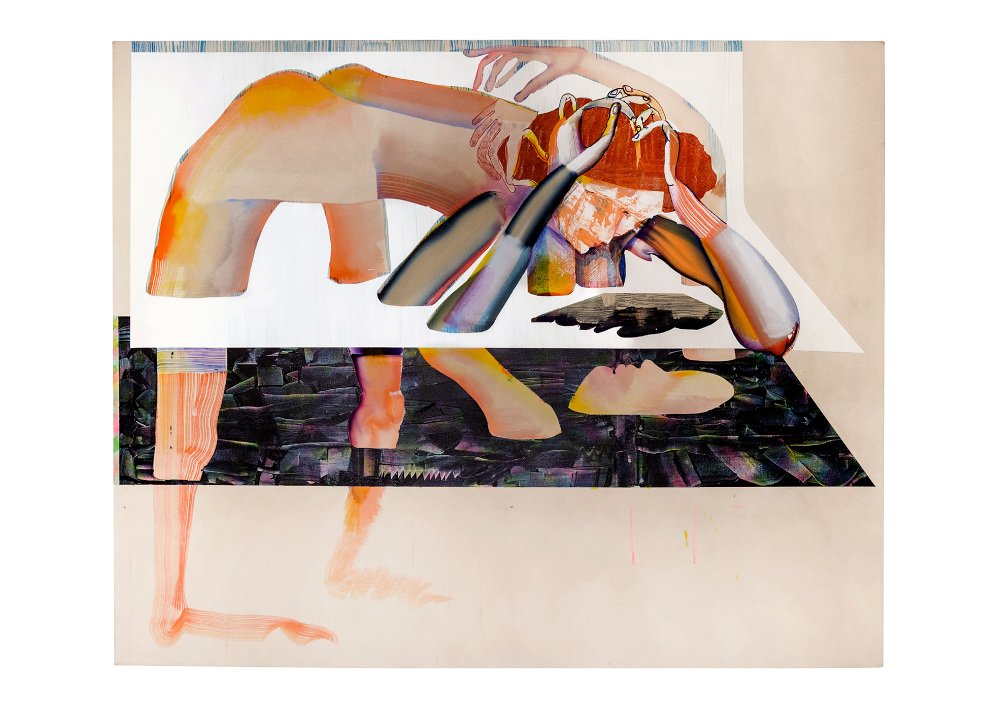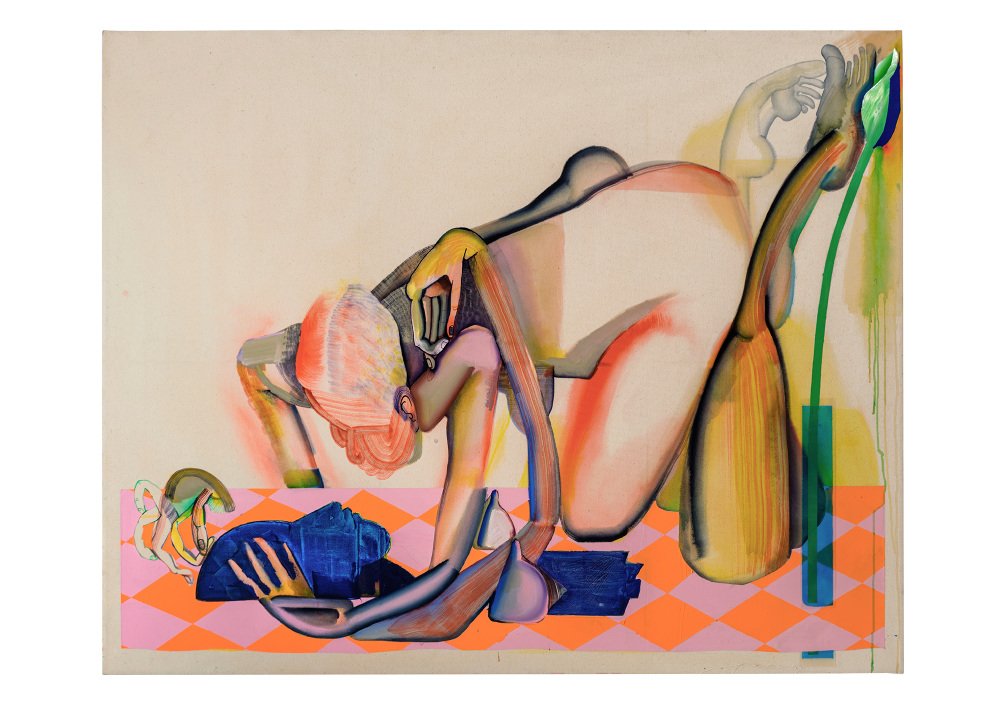The Emerging Christina Quarles:
Stagnation and Inconsistencies in The Discourse
Christina Quarles’ artistic career has taken off rapidly. Only five years since her graduation from Yale University’s MFA program, she has made an appearance in over 50 exhibits, 15 of which were solo. Despite her vast collection of new work in the last year and a half, the major shift in the world during the COVID-19 pandemic, and the evolution of her modes of portrayal as a result, the discourse around Christina’s work from both her commentators and herself have remained stagnant since her years at Yale, and reveal inconsistencies and contradictions. Quarles’ narrative is evidently rooted and takes shape from a solid liberal arts foundation which has very likely propelled her to meticulously unpack the themes of identity and intimacy she aims to explore, yet as her work evolves, the discourse remains the same: it remains an exploration of perception of self as a concept, heavily informed by her identity as a queer, white passing, mixed race artist, yet doesn't take into account the nuanced and more digitalized reconstructions of the work and evolution of artistic voice.
Quarles paints the intricate entanglement that can be the concept of identity in the form of corporeal enmeshment of human limbs and figures with vivid coloring and a range of textures and layering of acrylic paint. As a consistent theme throughout the years, Quarles’ compositions and seemingly erotically-charged, female-suggesting intertwined figurations defy gravitational pull and instead push, resist, and dissolve into each other as they push the boundaries of spacial coherence and planes. Quarles speaks to the uncanniness of our perception of identity: “We know ourselves as this fragmented jumble of limbs,'' as our ever-changing physical identity is the convergence point of “who we were, who we are, and all the moments in between.” This mode of portrayal makes an analogous effort to compel people to “question their own boundaries, whether they are self-imposed, artificially constructed or simply imaginary” and “encourage people who have never had cause to question their identity to do that. And maybe question everything else, too.”
The trend in the interpretations of Quarles’ work imply a multiplicity of characters in the figures performing acts of intimacy, considering erotic coupledom as a given, while Quarles speaks of her work as a single identity taking part in intimacy. Wendy Vogels’ descriptions invariably offer the presence of two people, “Doubled Down illustrates… a standing, naked woman [who] appears to be pulled down to the depths of hell by a lover [...] in A Shadow of Whut I Once Was, two female subjects embrace on a checkerboard floor that swallows the lower one whole.” Christina Naf alludes to the possibility of more than a couple, “we see multiple heads and arms attached to bodies that are stacked together, obscuring the individual figures’ borders until we cannot tell where one person ends and the other begins.” Quarles, on the other hand, contradictory to all her interpreters, proposes one individual facing the sense of multiplicity of identity and the concept of personal entanglement in memory, reflection, labels and characterizations imposed on people, both externally and internally, and strays far from suggesting that there is more than one person depicted in her work.
Central to her work’s intention is depicting what it feels to be in a body, “to be in a racialized.. gendered… queer body, really to be in any body and the confusing place that that actually is,” and she is less interested in depicting what a body looks like, and “more interested in painting what it is to be in your own body and experiencing the world and yourself through this outward looking that happens…the figures are a way of anchoring the viewer in this sense of physicality… the sort of fragmentation that happens of yourself when you are in your body and really at a disadvantage in a way of knowing yourself because you know all [your] contradictions, all the ways you exceed or don’t quite fit into these certain categories of identity that we’re placed in. And yet we experience a world of other people where [they are] these cohesive figures.” If the underlying pretense for her work is that the way one looks at others is coherent, yet the way her subjects are portrayed are heavily incoherent, then all the commentary around her work suggesting more than one individual directly contradicts her intentions.
Based on Quarles’ commentary, works like Tomorrow Comes Today (Come What May/Cum, Whatever, Maybe), and O Holy Nite, which appear to portray acts of kissing and lesbian sexual intercourse in the way the bodies are placed with respect to one another, and the varying levels of translucency and color schemes in what appear to be distinct figures engaging with one another, contradict her intention and provoke a sense of ambiguity of subject. If the figure is intended to be a portrayal of feeling in the moment of intimacy but does not portray any other individual, it must suggest either a multi-planar study of a moment in time or different moments during an event of intimacy in a given space. The ghost-like thinness, impostor brush strokes and lack of layering appears to be representative of a window into the more transient moments, and the flesh and carnal heavy build up of paint representative of a sensation of weight, density, or amplified feeling. The limbs defy physics uniting in ambiguity in their multiplicity of self while reflecting the contingency of memory or feeling of the self engaging with another body, without considering the other body as a subject of portrayal.
From the commencement of the pandemic in 2020, her works shift from incorporating backgrounds and layers that suggest domesticity and familiar figures like the textured couches on Sumday (We Gunna Rest on) Sunday, 2019, and the flowers and quilt-like patterns in Bits n' Pieces to integrate the appearance of a screen-like, omnipotent entity, notably more digitized and geometric than her pre-pandemic, “pre-zoom” work. At the beginning of a zoom lecture with the Anderson Ranch Arts Center, Quarles expresses how the pandemic has substantiated the “jarring-ness” of seeing her own body in a mirror, screen or video. “It’s funny that we’re talking about it right now in a conversation where I can see my work and your face and my face in this sort of equal grid, and so I feel like quarantine has really opened up this strange fragmentation of ourselves where these sort of disembodied figures that we all have this egalitarian playing field of being disembodied and seeing our faces simultaneously.” Yet the presentation continues to follow the habitual narrative with which she has presented her work in the last four years. That comment, nevertheless, might be an indication of the appearance of the omnipresent screen-like geometric shapes prominent in all of her work after 2020, meanwhile the discourse once again, stagnates to follow the expression of her MFA renditions.
Despite Quarles’ emphasis on the gestural process she follows, where she begins with no sketches or idea, and abstractly contours lines around the canvas that will indicate the outline of figure, the way which she responds to that actuality, and fills in the missing pieces portrays a more computerized aesthetic since the appearance of the screen-like objects in her paintings. Quarles reveals she plays around with Adobe apps to test possibility, and it seems like the COVID-19 pandemic has marked an apparent change, from a more corporeal, gestural aesthetic, present in works like Pull on Thru tha Night, 2017, where the background carries organic wave-like forms, to a digitalized understanding of the space-time contingency with works like New Moon, 2021, that show the geometrical flatness of a rigidly- outlined horizontal screen, which interacts with the bodies in a way that emphasizes the computerized two-dimensionality of the figure as they transcend out of or into the screen. In her usual discourse, Quarles asserts that the non-bodily elements and backgrounds in her paintings serve as an anchor into pop-culture and familiarity of physical objects and patterns, yet the discourse falls behind by the lack of mention of how the increased screen-time and self perception during the Zoom era has played a role in her subjects of portrayal.
Works Cited:
1.Selvin, Claire. “Christina Quarles on the Intricacies of Figuration and Selfhood,” ARTnews. ARTnews, April 15, 2021. https://www.artnews.com/art-news/artists/christina-quarles-artist-interview-1234589606/.
2. Molesworth, Hellen. “Summer Series: Christina Quarles in Conversation.” Anderson Ranch Arts Center, January 27, 2021. https://www.andersonranch.org/blog/2020-summer-series-christina-quarles/.
3.Nafziger, Christina. “Boundary Crossing: A Review of Christina Quarles at the MCA” Newcity Art, May 15, 2021. https://art.newcity.com/2021/05/10/boundary-crossing-a-review-of-christina-quarles-at-the-mca/.
4. Vogel, Wendy. “Christina Quarles.” ARTnews.com. ARTnews.com, March 29, 2021. https://www.artnews.com/art-in-america/aia-reviews/christina-quarles-62482/.







